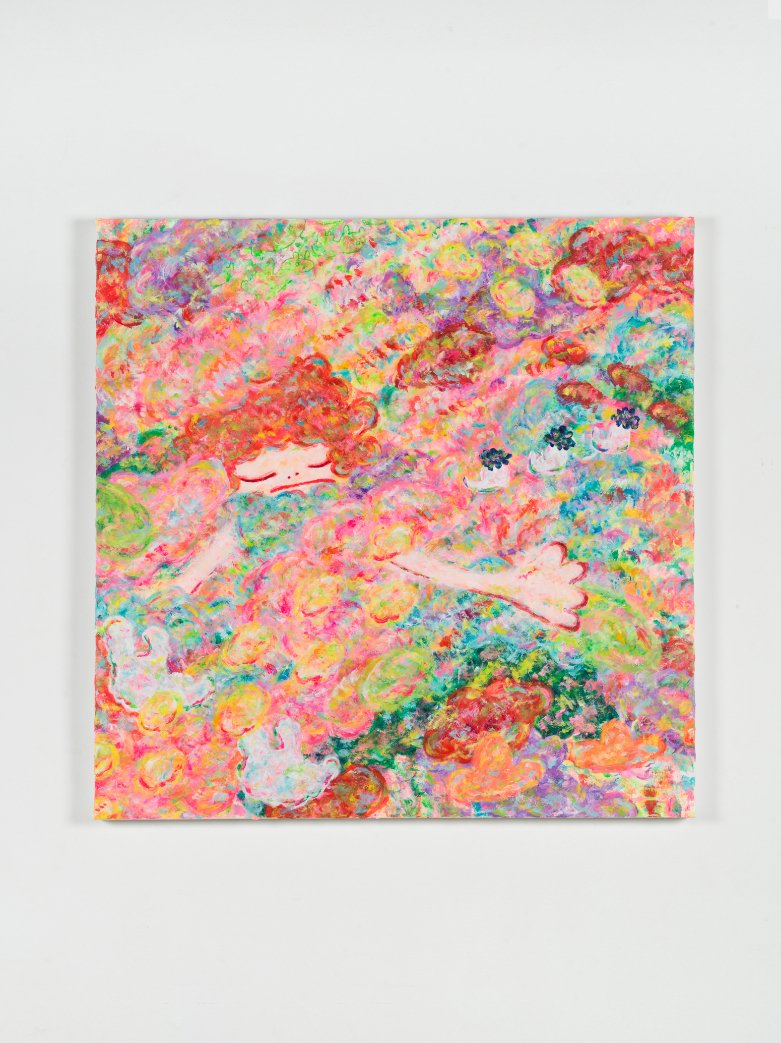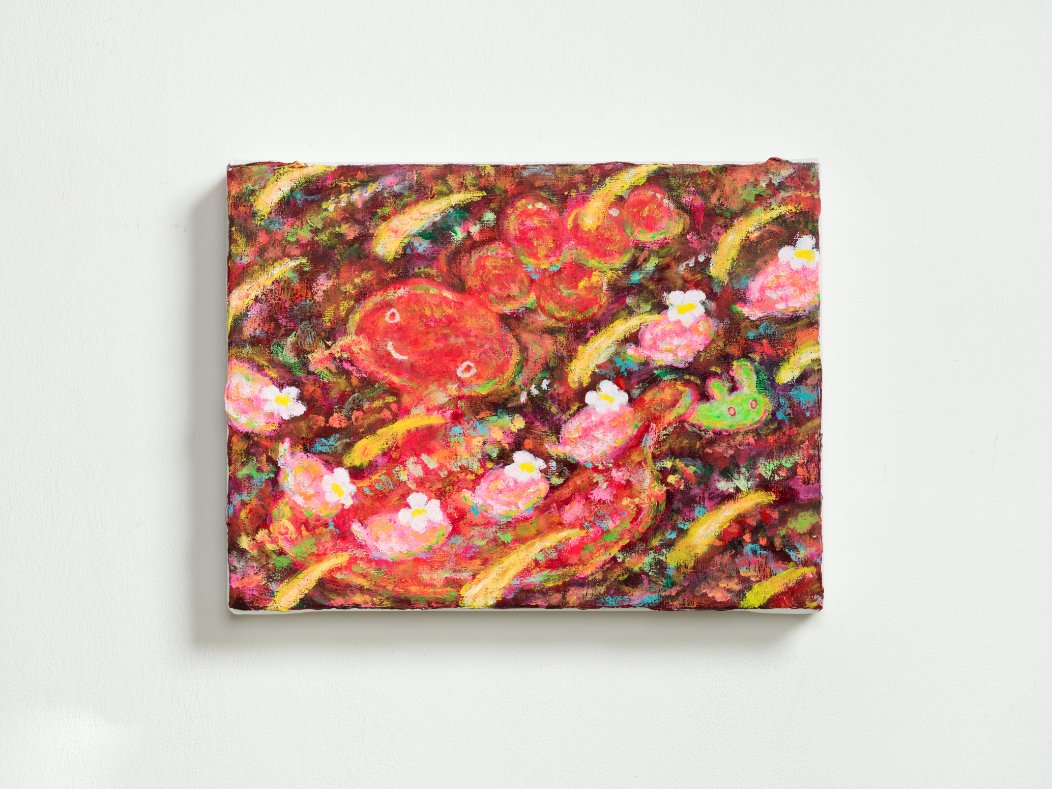interview by AUTRE
photographs by Roman Maerz. Courtesy of the artist and KÖNIG GALERIE, Berlin, London, Seoul and Vienna.
The large, expressive eyes peering out from Ayako Rokkaku’s paintings seem to mirror the viewer, as her work inevitably evokes a sense of wonder and joy that beckons the gaze. The self-taught artist paints using her bare fingers and hands to layer the figurative and the abstract in clouds of color, resulting in dynamic, imaginative imagery that draws from impressionism, abstract expressionism, and the kawaii aesthetic of Japanese manga. We spoke with Rokkaku about her inspirations, her practice, childhood, and her new works which will be shown at Frieze LA, presented by König Galerie.
As a self-taught artist, when did you realize that working with your fingers and hands helped you produce your painterly, impressionistic visions on canvas?
When I was 20 years old and when I hadn't got my style yet, I participated in an event in Tokyo for amateur artists for the first time. I did live painting there. I prepared some materials (brush, pen, crayon, paper, etc) and tried some methods of painting. I was painting on the used cardboard on the floor with acrylic paint on my hand and it came to me. I felt that I was able to leave a trace of something like an improvisational and primitive impulse on the cardboard and it fit me well.
Your paintings are fully realized and mature, but there is a very childlike freedom to them. Did you paint when you were a child and what did you paint or draw?
I liked drawing when I was a child, and I remember I liked putting colors more.
It feels fun when the paper gets vivid and lively as I put more colors on it. But it was after I grew up when I started to look carefully and think more about children’s drawing. I’m trying to keep the impression of pureness and freedom like children’s drawing in my works.
Who are some Japanese or international artists that inspired you growing up?
I’m impressed by Cy Twombly, Jackson Pollock, Willem de Kooning. I also like Monet, Klee, Matisse, etc…
There has been a tradition of artists painting as performance. For instance, Yves Klein — is there a particular difference between painting in front of a crowd versus the solitary environment of a studio?
I'm happy to be able to share the time and process when a painting is born, not only a finished work with the people there. It makes me feel like I'm drawing with the energy of the people there. And it is fun for me, by continuing to paint without thinking too much and without fear of failure in a limited time, sometimes unexpected techniques and motifs are born. On the other hand, when painting alone in the studio, it feels like playing — catching the energy ball between the canvas and myself.
Do you see yourself following in a similar trajectory as the Superflat artists of post-war Japan, or do you categorize your work in a totally separate arena?
I've never been conscious about it. Maybe I’m in the trajectory, but personally, I don’t feel I’m in any group.
What have artists like Takashi Murakami taught you about painting. Is there a particular lesson that sticks with you?
When I was 24 years old, Takashi Murakami invited me to join the Kaikaikiki booth in the Volta art fair in Basel. At that time he taught me that just liking painting is not enough to survive in the contemporary art world, and how he is fighting so hard with keeping the spirit of the artist. He never taught me about any technical things, but without him I might not have chosen to continue as an artist.
Do you see your work changing over the years—becoming more or less impressionistic, or abstract, or have the colors evolved?
It is getting less improvised, part graffiti-like, and the number of colors and layers has been increasing. Before, concrete figures such as girls and abstract parts were often more clearly separated. Nowadays, sometimes there is a girl behind the abstract layer, or the skirt or hair are directly continuing to the flow of clouds, so the border between abstract and object is becoming less. I think that the intention to create upward and free energy in the works has not changed.
How has Japanese anime and manga inspired your work? You have recurring symbols, like clouds and childlike figures. What do these figures represent?
It was not uncommon that anime, manga, and something cute (kawaii in Japanese) were more or less blended into daily life throughout my childhood in Japan. Cute characters, or characters with a strong and gentle heart, can be close to any person's heart. We can synchronize with them and they will lead to various new worlds. I maybe want to make the girl, the clouds, or abstract shapes as a way of expanding the imagination.
You also make sculpture. Is there a different approach that you take with the three-dimensional?
I have less experience in sculpture than in painting, but like my painting, I don't make a plan for what it will be in the beginning. It´s like the shape is gradually decided while I enjoy the feeling of the material, such as wool, cray etc, and searching for a wired but cute, and interesting shape.
What do you think is the most understood thing about Japanese artists from an international perspective?
I’m not sure. A tendency to cherish subtle emotions, atmosphere, and transitions?
Has the pandemic changed the way you make art or think about art?
It hasn’t changed, but re-recognized, it is important for me that people can see and feel the art works directly.
As a young, creative person—with all the political and climate uncertainty in the world—does the anxiety of the zeitgeist creep into your work at all?
I don’t use specific political or climate issues directly as my concept, but I believe in any age, childlike pureness or the kinds of questions we have as children, are necessary for keeping ourselves together psychologically. I hope my work serves as a reminder of that.
Your new series represented at Frieze, can you talk about them a little bit - is there a specific correlation or connection between them?
I will show six paintings that are continuing to each other. There are girls, each are in the different layers — one is in the very front, or one is almost hiding behind clouds, or between. And also, each color is in different motifs in the other canvas, so object and abstract changes in different canvas. So, people may get a feeling of floating in the clouds in the layer outside of canvas.
What do contemporary Japanese artists think of Los Angeles?
I like the city where I can easily go walking or take a bicycle around small streets, Los Angeles is so huge for me! But also it is nice to get inspired by its vastness of scale.





